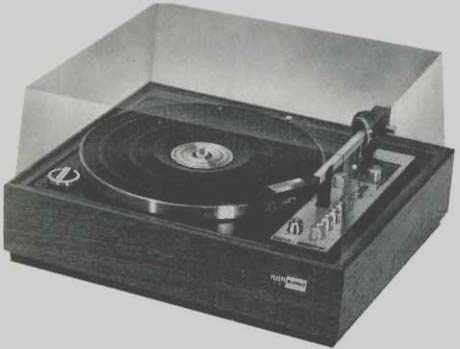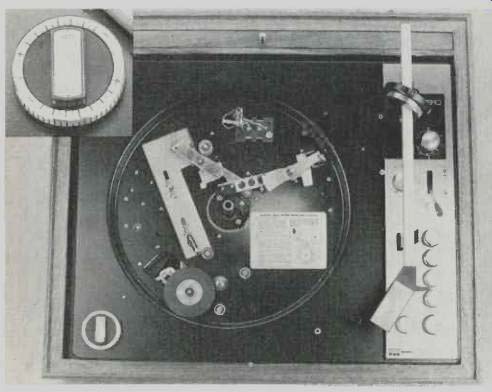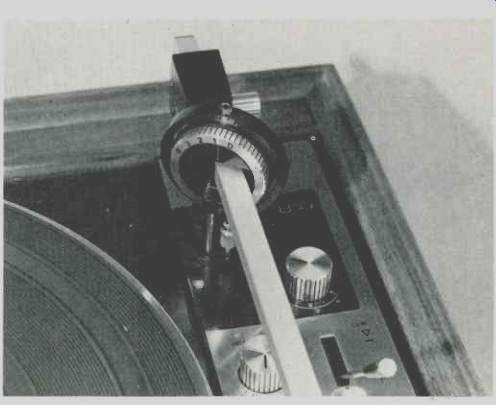
MANUFACTURER'S SPECIFICATIONS
Speeds: 33 1/3 and 45 rpm.
Wow and Flutter: Wow, 0.1% rms; flutter, 0.05% rms. Motor: Synchronous/Induction.
Platter: Die-cast, non-ferrous, 12" diameter; weight, 7 1/2 lbs.
Push button operation. Adjustable anti-skating control.
Stylus Force: Adjustable from 1 to 4 grams. Cueing control, automatic arm lock. Square aluminum tone arm, gimbal mounted. Knob-adjusted counterbalance. Rotating single record spindle. Pitch Control: ±3%. Dimensions: 17 1/8 in.
W. by 15 1/8 in. D. by 9 1/2 in. H. (over furnished dust cover).
Weight: 19 lbs.
Price: $ 149.50, with base, dust cover, and Shure M 91E cartridge, $239.95.
This is the top-of-the-line model from BSR, the newest of a group of "total turntables" which are almost ready to go as soon as you take them out of the box. The 810 is complete with base (which is enclosed on the bottom), dust cover, and a Shure M91E cartridge already installed in the removable cartridge slide. This eliminates the need for shopping for a separate cartridge, base, and dust cover.
As the top-of-the-line model, its performance ranks along with every other top-line turntable we have profiled to date. The 810 is similar in appearance to other top turntables-the platter off center in the chassis, speed control, and arm in all the usual places. But the speed control is different-a rocker type lever is centered in the vernier speed control, and the user simply pushes one end or the other of the rocker to change speeds. Integral with the turntable mat is a stroboscope disc, with two being furnished to be used with either 60 or 50 Hz viewing light, and an additional motor pulley is supplied so the user can change from 60 to 50 without having to wait for a new motor pulley from the manufacturer in case he moves from the U.S.A. to any other country where 50-Hz line frequency is common. Similarly, the user can change from 120 volt operation to 240 if his new supply is at the higher voltage.
Power connections and ground are made with the usual 4-pin connector on the chassis, with the leads connected to a female receptacle--interchangeable with most turntables sold for high-fidelity use.

Fig. 1--Top view of the turntable with the platter removed and without the
arm counterbalance. Note the compartment cover at the rear which protects
the 45 adapter and whichever spindle is not in use. The inset shows the speed
change control--a rocking lever--and the vernier speed adjustment

Fig. 2--The arm-mounting gimbal has the anti-skating control at its right
and the set-down control directly in front.
Stylus force is set by the large ring on the gimbal. The cue lever is shown at the right front.
Mechanically, this turntable differs considerably from practically all others. There is no large cam rotated during the cycle by gear teeth on the turntable engaging those on the rim of the cam, with all the mechanical motions thereby actuated by the convolutions of the cam surfaces. Instead, the 810 employs what is called a "sequential cam system" which consists of eight pre-programmed cams located on a shaft which runs parallel with the chassis. The action is quieter and apparently completely reliable.
To actuate the turntable, there is a panel at the right front of the chassis which accommodates five pushbuttons and a knob.
The latter switches the action from single to automatic operation, while the buttons activate START for manual operation, STOP, and START at diameters of 12, 10, and 7 in. respectively.
Further back in the panel is the cue lever, which is pulled forward to lower the stylus to the record or pushed back to lift the arm. To the left of the cue lever is a knob which adjusts the set-down position of the arm from a minimum of 5 1/2 from the center of the record to a maximum of 6 1/8 inches when set for a 12-inch record. Two triangular marks indicate the nominal limits for average records.
Behind the satin finished panel is another knob with two scales for setting the anti-skating control for either conical or elliptical styli. After balancing the arm with the flexibly mounted counterweight, using the knob for fine adjustment, stylus force is then set with the large ring which is part of the gimbal in which the arm is supported. Stylus overhang can be adjusted by moving the cartridge adapter on the slide, with the exact position being indicated by a plastic fitting which slips over a split pin on the chassis. After achieving correct adjustment, the indicator is removed and replaced with a stylus-cleaning brush which slips over the same pin. Every time the arm passes over the brush, the stylus is wiped clean.
The single record spindle slips over the center bearing of the platter and rotates with it, while the automatic spindle drops into a hole in the center bearing. Leads from the arm are carried in a shield, consisting of a long spring coil, and connect under the turntable platter to a pair of phono jacks into which the paired cable plugs from the underside. On the whole, the 810 appears to be well designed and well built in every particular.
Performance
Measured performance of the 810 indicated a very low wow figure of 0.06 per cent, and an equally low flutter of 0.06both unusual, since most turntables show slightly more wow than flutter. This is somewhat better than the specified 0.15 total. Similarly, hum, noise, and rumble measured 44 dB below the 1000-Hz level of 3.54 cm/sec, unweighted. This corresponds closely to the specified level of 1 cm/sec at 100 Hz, and when compensated for ARLL (audible rumble loudness level, commonly reported by others) corresponds to about -63 dB, which is excellent. With the synchronous/induction motor, there was no speed variation with change in frequency, and none over a voltage range from 85 to 135 volts.
Cycling time measured 16 seconds from a standing start, and 12 seconds from trip to setdown in the automatic mode. The vernier speed control varied the speed from the normal 33 1/3 by 1 per cent downward and by 4 per cent upward, resulting in an overall range of 5 percent, which is only slightly less than usual. One interesting feature is the ability to repeat a single record as long as desired. The single-play spindle is inserted and the AUTO/SINGLE knob turned to the AUTO position, and upon starting by depressing either the 12, 10, or 7 button, the record will be played continuously until the stop button is depressed.
BSR is to be complimented on the clarity and completeness of the owner's manual which comes with the 810. Full instructions are given for changing the motor spindle and for changing the unit for the required line voltage. This information should save the owner from having to locate a qualified service man if such changes are required--the owner can join the do-it-yourself cult quite proudly.
-C. G. McProud
(Audio magazine, Jun. 1972 )
Also see:
BSR 710/X Total Turntable (Feb. 1974)
BSR 810 turntable (ad, Mar. 1973)
BSR 810 and 710 turntables (Oct. 1973)
BSR turntables (ad, Apr. 1974)
BSR turntables (ad, Apr. 1975)
Connoisseur Model BD2A Turntable (Equip. Profile, Jul. 1980)
= = = =